Foreword
Artificial Intelligence (AI) was once hailed as something far-fetched and fictional, but almost overnight, it became part of people’s daily lives. Today, AI outpaces even the rise of the dot.com boom, with today’s headlines now dominated by deepfakes and chatbots like Google Gemini and ChatGPT. However, the current debate often overlooks small businesses and the self-employed.
There are 5.5million small businesses in the UK and with 20 per cent already using AI, their role in AI’s trajectory is undeniable. Small firms are agile and can make quick changes to their operations, so with the right framework, they will be able to embrace AI at pace. Forgetting them when looking at the opportunities – and risks – AI will bring would be a grave error.
But with AI’s rapid growth, the need for a balanced regulatory framework is urgent. Whether small businesses and the self-employed are adopters of AI or creators of AI, they face vulnerabilities that larger tech companies will be less at risk of. Our report shows that 25 per cent in the information and communication sectors, for instance, fear AI may undermine the long-term viability of their business. Regulation, therefore, is key.
AI powered technologies have the potential to improve business investment and foster growth. The role of Government extends beyond managing threats – it has a pivotal role to play in boosting digital trade, raising productivity, and breaking down barriers to tech adoption.
One of the most important priorities for policymakers is to address the AI skills gap, with 46 per cent of firms lacking the knowledge to integrate AI. We might not have flying cars or time travel in our future like popular culture promised, but we do have AI – and it has the potential to bring endless benefits to the economy. But before it does, we need to ensure we’re creating the right environment for small firms to thrive in.

Tina McKenzie
FSB Policy and Advocacy Chair
Infographics
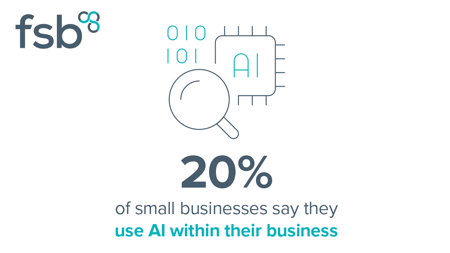
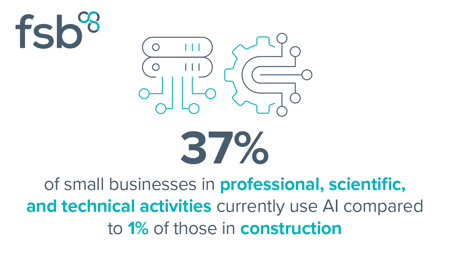
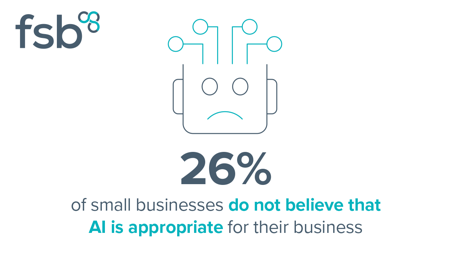
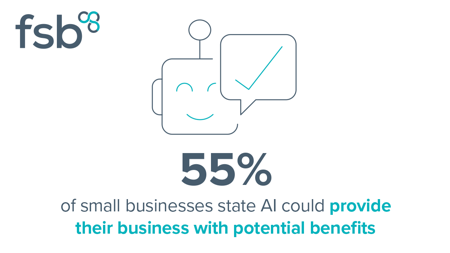
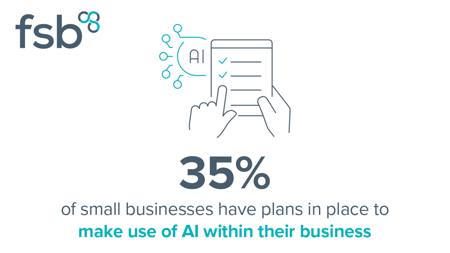
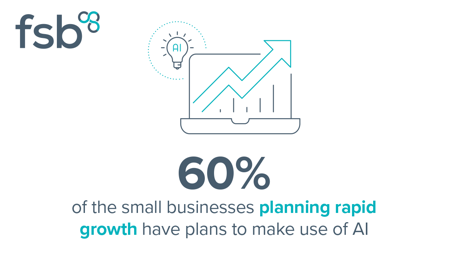
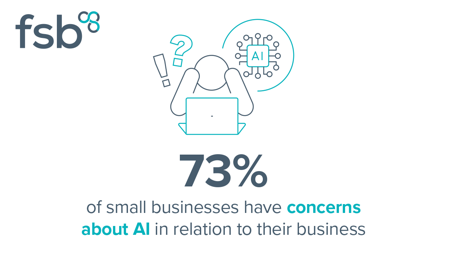
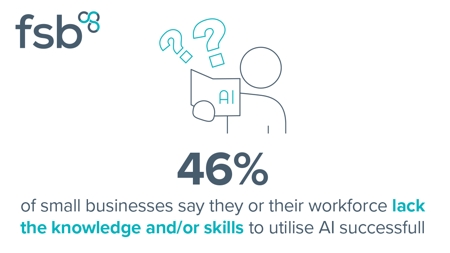
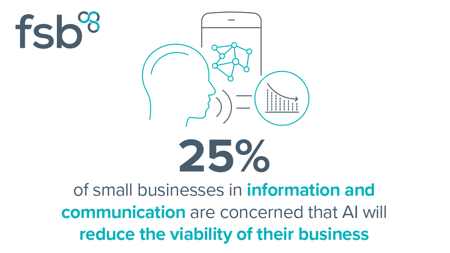
Key findings
Small business use of AI
- 20 per cent of small businesses say they use one or more of the below technologies within their business:
- Generative AI (12%)
- Machine learning (3%)
- Predictive AI (5%)
- Robotics (1%)
- Computer vision (2%)
- Natural language processing (5%)
- Deep learning (2%)
- Other technology related to AI (2%)
- This varies by sector:
- 37 per cent of small businesses in professional, scientific, and technical activities
- 34 per cent of small businesses in information and communication
- 14 per cent of small businesses in manufacturing
- 12 per cent of small businesses in accommodation and food services
- 11 per cent of small businesses in wholesale and retail
- 1 per cent of small businesses in construction
Benefits
- 55 per cent of small businesses state AI could provide their business with potential benefits. These include:
- Working more efficiently (40%)
- Being able to automate tasks (29%)
- Developing / improving products and services (24%)
- Improving customer experience (22%)
- Providing cost / budget savings (21%)
- Gaining insights into their customer base (18%)
- Eliminating administrative jobs (15%)
- Initiating new business models (13%)
Concerns
- 73 per cent of small businesses, however, still have concerns as to how AI might potentially impact their business.
- 46 per cent of small business owners say they or their workforce lack the knowledge and/or skills to utilise AI successfully.
- 31 per cent of small businesses are concerned about their ability to manage AI securely / manage security risks.
- 29 per cent of small businesses say that large businesses have more resources to better utilise AI.
- 24 per cent of small businesses are concerned over the impact of deepfakes on their business brand / reputation.
- 20 per cent of small businesses are concerned about the abuse of their Intellectual Property (IP) rights.
- 12 per cent of small businesses are concerned that AI will reduce the long-term viability of their business.
- For the small businesses who currently use AI:
- 37 per cent say that large businesses have more resources to better utilise AI.
- 35 per cent have concerns about abuse of IP rights.
- 31 per cent are concerned about the commercial impact of deepfake technology.
- 40 per cent of small businesses in manufacturing say that large businesses have more resources to better utilise AI.
- 30 per cent of small businesses in wholesale and retail say they are concerned about the impact of deepfake technology.
- 25 per cent of small businesses within the information and communication sector are concerned about the future viability of their business due to AI.
Plans for the future
- 35 per cent of small businesses have plans to make further use of AI within their business in the next two years. Specifically, they plan to:
- Undertake a course to improve their skills / knowledge in AI tools / technology (16%)
- Explore new AI technologies to initiate new business models (13%)
- Use AI to improve customer experience (13%)
- Review internal / customer facing processes to see what could be automated (12%)
- Use AI to drive cost / budget savings (9%)
- Use AI to gain insights into their customer base (8%)
- Invest in workforce training to upskill their staff to use AI tools / technology (8%)
- Hire a consultant to enable their business to make better use of AI (2%)
- Of the small businesses that are planning to grow rapidly in the next 12 months (increase turnover/sales by more than 20%), 60 per cent have plans to make use of AI within their business.
- Over a quarter (26%) of small businesses do not believe that AI is appropriate for their business. This varies by sector:
- 51 per cent of small businesses in construction
- 45 per cent of small businesses in accommodation and food services
- 34 per cent of small businesses in wholesale and retail
- 25 per cent of small businesses in manufacturing
- 10 per cent of small businesses in professional, scientific and technical activities
- 5 per cent of small businesses in information and communication
Recommendations
A pro-growth regulatory framework
The Cabinet Office and the Department for Business and Trade should:
- Conduct a review of how best to support regulators and HMRC to effectively use AI tools within their internal and customer facing processes. The aim of this review would be how to improve their customers’ experience and to reduce the volume of regulatory requirements facing SMEs. (pp.37-38)
The Department for Science, Innovation and Technology should:
- Introduce legislation that ensures that all AI created output, that is being shared without any human making changes to the output, has a watermark or disclaimer inserted that clearly outlines that the content has been generated solely by AI. This will be a duty on technology companies, which will be monitored and enforced by regulators. (p.30)
- Broaden the remit of Ofcom so that it includes regulation of cloud services in the same way that utility providers are currently regulated. Ofcom would be charged with ensuring that cloud infrastructure remains affordable, and providers do not charge excess egress fees. The provision of cloud services is an increasingly vital part of the national infrastructure, and it should be treated as such. (p.38)
- Introduce an obligation on the providers of the largest foundation models to provide information and documentation to downstream AI developers who intend to integrate the general-purpose AI model in their systems. Additionally, for these foundation model providers to be required to keep up to date technical documentation of the model for oversight purposes. (p.38)
- Build on work from the AI Safety Summit to ensure international regulator to regulator co-ordination and cooperation in sharing information and where necessary in progressing action. Future summits could also consider how to build trust in AI and involve a wider range of businesses in discussions. (p.38)
The Department for Science, Innovation and Technology and the Intellectual Property Office should:
- Request the Law Commission conduct a review into the use of Artificial Intelligence and how it relates to Intellectual Property and how best to update the Copyright, Designs and Patents Act 1988 to provide clarity that copyright protection can only sit with a human author. (p.33)10
- Effectively enforce copyright laws to protect the output of authors, creators, and other publishers from misappropriation and misuse from developers of foundation models. Additionally, to establish a trustworthy and transparent system for auditing the use of copyrighted material in AI systems. (p.33)
The Department for Business and Trade should:
- Use Free Trade Agreements to secure protections on personal data and intellectual property as well as to encourage innovation and facilitating the free flow of data. (p.39)
- Consult on whether existing pieces of legislation such as the Equality Act 2010, UK GDPR and other employment laws provide necessary safeguards and sufficient meaningful human oversight to meet the use of AI in the workplace. In addition, a future consultation should also consider whether specific legislation is required to provide effective legal protections for employees, workers and employers. (p.41)
The UK Government should:
- Enhance the resources and powers of the Digital Regulation Cooperation Forum (DRCF) to maintain a co-ordinated approach to AI regulation and ensure international interoperability. The DRCF should also become the first port of call for reporting new or suspected risks with AI, without fear of enforcement. (p.39)
The Competition and Market Authority (CMA) should:
- Review and enforce data interoperability between different software that require large data input from SMEs. (p.38)
The Ministry of Justice should:
- Update existing legislation so that the use of deepfake technology with the intent to cause commercial damage is clearly illegal and victims have potential legal remedies open to them. (p.31)
UK Government and National Cyber Security Centre should:
- Review the pricing of Cyber Essentials certification as well as costs associated with annual renewal in relation to the smallest businesses and explore whether lower tier pricing or a special reduced rate could be introduced. (p.31)
Skills and AI adoption
HM Treasury should:
- Establish an independent body that looks at the current and future labour market and provides policy recommendations across Government departments. The independent body should develop short, medium and long-term labour market strategies and to consider the labour market implications of increasing AI use. (p.47)
- Increase the Corporation Tax relief for employers training low or medium-skilled employees. To encourage employers to train those with lower qualifications, the relief should remain at 100 per cent those employees with a prior Level 6 qualifications, increased to 160 per cent for those without a prior Level 6 qualification and raised to 230 per cent for those without a prior Level 3 qualification. (p.48)
The Department for Business and Trade should:
- Include information and training within their export support programmes such as the Export Academy on how small businesses can use AI in their business processes to cut down on the administration. (p.26)
- Review their use of AI when gathering/analysing data on trade to inform future policy decisions in order to encourage and enable SMEs to export. At the same time, the Department should bear in mind security concerns around sensitive/commercial data. (p.27)
- Develop a tech adoption and digital skills diagnostic tool. This would provide small business owners with advice on what business processes they could potentially automate and advice/signposting to encourage them to do so. Within this tool, there could be an assessment of a company’s current and future digital skills needs and what training would help them and/or their employees. (p.44)
- Introduce digital audit vouchers for small businesses to enable more small firms to think about how they are using data and technology, vouchers should be introduced to enable them to audit their tech needs and what technology they should consider adopting. (p.44)
- Develop an Automation Fund, providing small businesses with grant funding to automate processes where access to labour is challenging. (p.44)
- Incorporate within the Help to Grow: Management course, a section on the successful use of AI within businesses. This should also be included within Help to Grow: Management Essentials, which FSB has been strongly supportive of and welcome its launch. (p.44)
- Establish similar bodies to Made Smarter for different sectors across the country – these organisations should be focused on enabling small businesses to adopt innovation and technology, including AI. (p.45)
The Department for Science, Innovation and Technology and Innovate UK should:
- Build on the approach of BridgeAI for the long term, with less focus on further research and international collaboration and more focus on effective engagement with small businesses. This must include working with pre-existing government business support infrastructure. (p.45)
The Department for Education should:
- Maintain Skills Bootcamps in the long term and develop two new ones - ‘The basics of using AI for business’ and ‘Adopting technology within business processes.’ (p.48)
- Ensure that digital related qualifications are available to all students, who wish to study them, at GCSE and A Level. In addition to computer science, the government should introduce an applied computing GCSE, which is less theoretical than computer science and focused on the digital skills required in the workplace. Both of these courses should cover the basics related to AI. (p.48)
The Institute for Apprenticeships and Technical Education should:
- Develop an apprenticeship standard at Level 2 that is reflective of the digital skills needs of a small business, including the basic use of AI. (p.49)
Download the full report below




